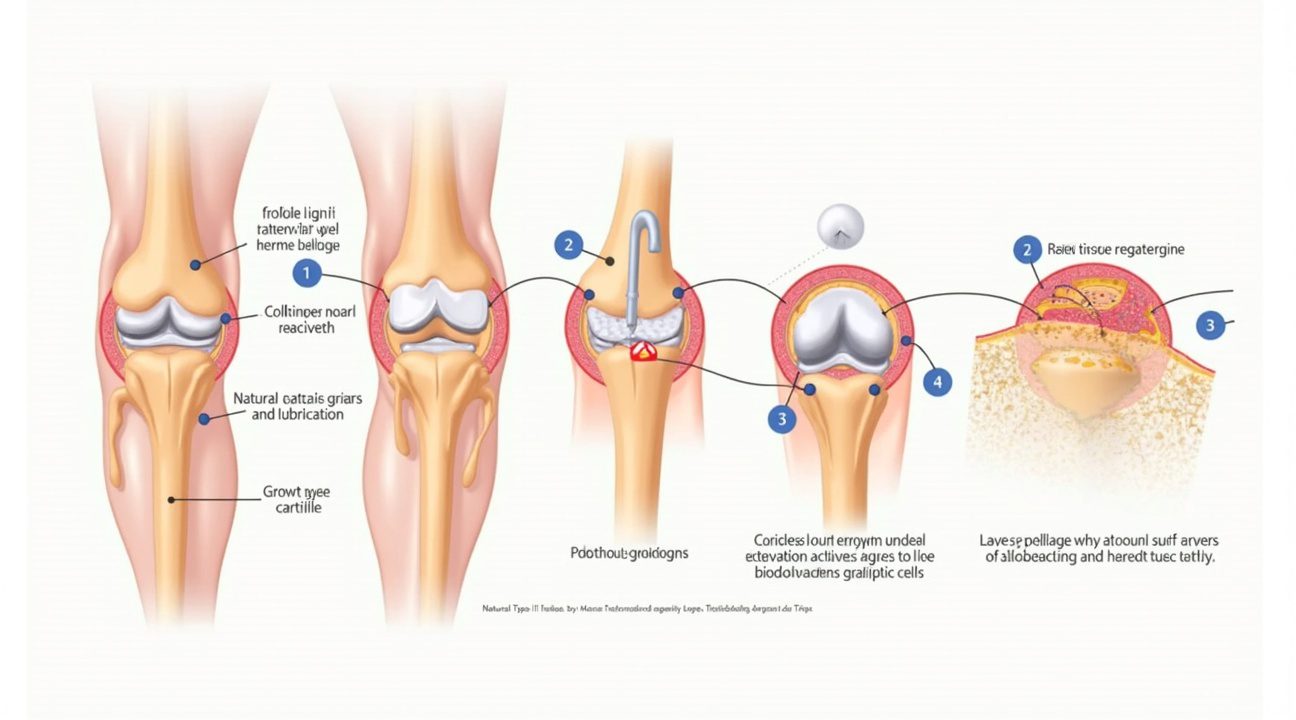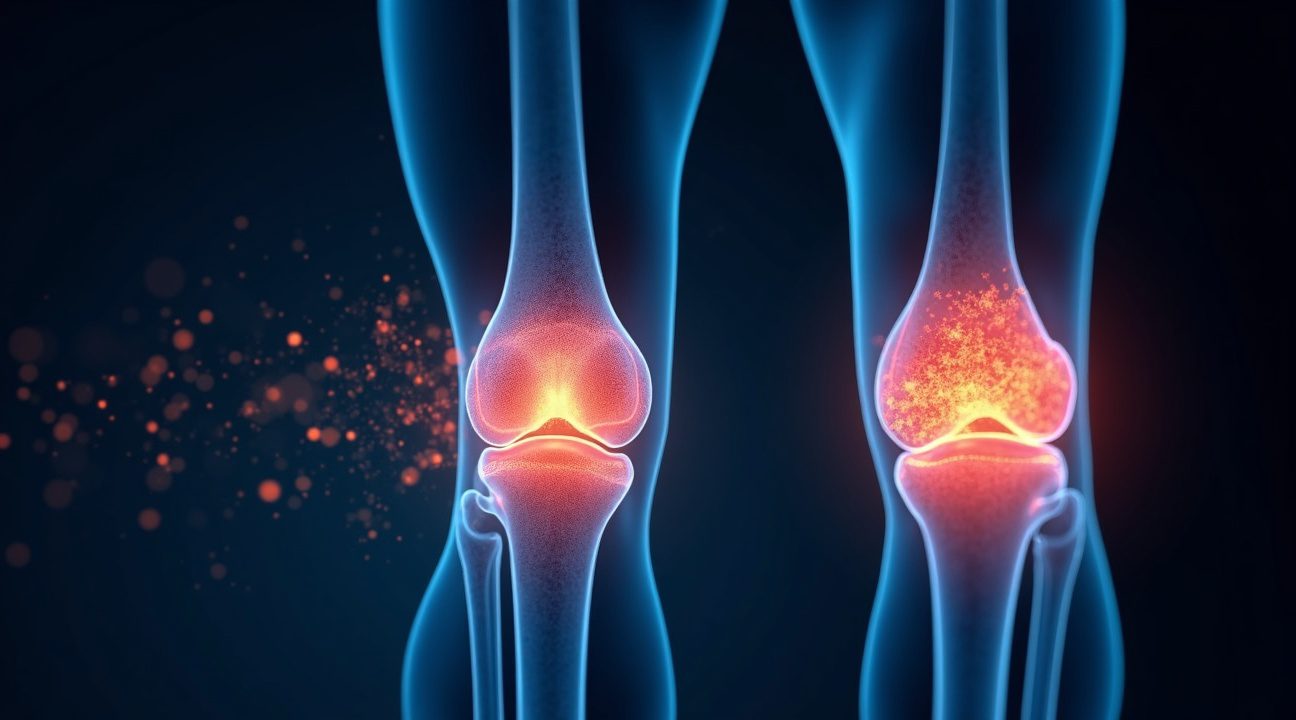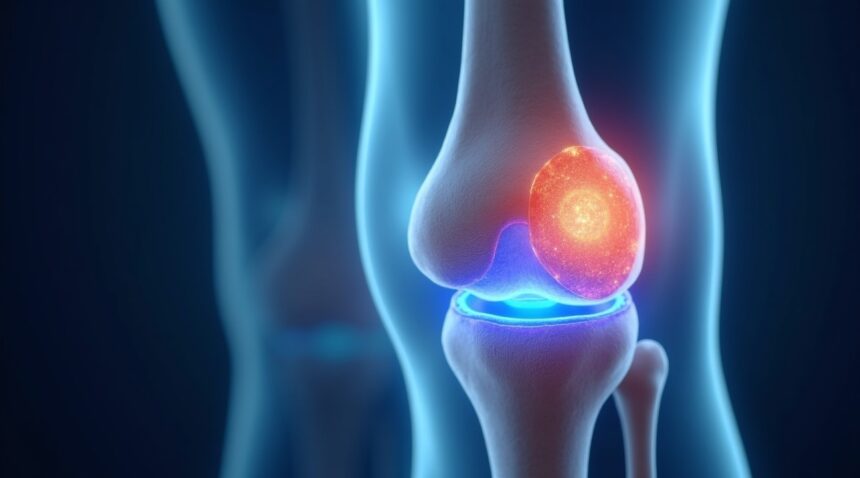Revolutionary Cartilage Regeneration Gel Developed by German Scientists
German researchers have unveiled a groundbreaking injectable cartilage regeneration gel that mimics the precise biochemical conditions needed for natural cartilage repair—offering a minimally invasive alternative to surgery.
This cutting-edge treatment stimulates the body’s natural repair mechanisms using biodegradable components that dissolve completely after healing, leaving only healthy, regenerated cartilage behind. The technology is designed to replicate the environment present during embryonic development of cartilage, prompting adult tissue to respond similarly—rapidly regenerating new, strong joint tissue.
Key Takeaways
- Biocompatible Components: The gel contains essential biopolymers such as collagen II, proteoglycans, and targeted growth factors that stimulate natural cartilage growth without harvesting cells from the patient.
- Superior Long-Term Healing: Five-year clinical studies demonstrate significantly better results than standard microfracture techniques, with MRI scans showing sustained cartilage restoration.
- Biodegradable Design: This cell-free gel eliminates permanent foreign materials, reducing complications and making it ideal for those unable to undergo surgery.
- Functional Recovery: Lab tests confirm that new cartilage matches the original tissue in durability, flexibility, and shock absorption—restoring joint function within six months.
- A Wide Range of Applications: Ideal for degenerative diseases, sports injuries, and age-related damage, this treatment provides hope to those historically considered poor candidates for cartilage repair.
How the Gel Works
The innovative material acts as a temporary scaffold, delivering biochemical signals and mechanical support required for cartilage regrowth. Collagen II fibers create the necessary framework, while proteoglycans retain moisture to ensure elasticity and cushion. Embedded growth factors stimulate dormant progenitor cells in the joint to produce new cartilage matrix without requiring invasive cell harvesting procedures seen in older techniques.
Minimally Invasive and Time-Efficient
This injectable therapy can be administered in less than 30 minutes in an outpatient setting. Unlike traditional treatments, it does not require the surgical removal of cartilage from other parts of the body, thus avoiding secondary complications and extended recovery periods.
Clinical Results
Clinical trials conducted at multiple centers show that 78% of patients experienced complete lesion filling according to MRI scans, compared to 34% using microfracture techniques. Functional joint assessment scores improved by an average of 85 points, and patients reported significant pain relief within two months, with continued gains up to six months.
The Benefits of Biodegradable Design
As new cartilage tissue takes form, the gel matrix naturally degrades into non-toxic byproducts that the body either absorbs or excretes, avoiding the chronic inflammation or immune responses sometimes seen with permanent implants. This truly regenerative approach promotes complete and lasting healing.
Mechanical Performance
Laboratory tests using pressure equipment validate that regenerated cartilage achieves the same mechanical strength as healthy tissue. These evaluations include measuring compression tolerance and rebound ability to ensure the new material supports normal joint loading and movement patterns.
Applications Across Age Groups and Conditions
This versatile solution caters to a wide patient demographic:
- Young athletes recovering from isolated injuries
- Middle-aged adults with early joint degeneration
- Seniors managing localized cartilage deterioration
Research confirms strong performance across joint types as well, including knees, shoulders, and ankles.
Personalized Medicine Potential
Future development is focused on creating patient-specific gel formulations. By analyzing a person’s genetic profile or inflammatory markers, scientists aim to enhance individual healing responses through custom-tailored treatment plans. This would mark a dramatic advancement in applying precision medicine to orthopedic care.
A Paradigm Shift in Orthopedics
By addressing the biological challenges of adult cartilage repair—such as insufficient progenitor activity and lack of structure—this gel represents a major breakthrough. It enables true tissue regeneration rather than temporary symptom relief, potentially transforming standards of care for joint injuries worldwide.
For more information on cartilage regeneration innovations, you can explore ongoing developments and breakthroughs through resources like PubMed Central.
How the Biomaterial Technology Creates New Cartilage From Within
The German gel works by recreating the exact biochemical environment that hyaline cartilage needs to regrow naturally. Instead of relying on complex surgical procedures, this breakthrough technology harnesses the body’s inherent regenerative capabilities from the inside out.
Critical Components Drive Natural Regeneration
The gel contains key biopolymers that serve as building blocks for healthy joint tissue:
- Collagen II provides the structural framework that gives cartilage its strength and flexibility
- Proteoglycans create the cushioning matrix that absorbs shock and maintains joint lubrication
- Specialized growth factors trigger the body’s natural repair mechanisms
- Biodegradable scaffold materials guide new tissue formation
This cell-free approach eliminates the need for harvesting cells from patients, making the treatment significantly less invasive than traditional methods. The gel essentially tricks the body into believing it needs to rebuild cartilage in the targeted area.
Once injected into damaged joints, the biomaterial begins working immediately. The synthetic cartilage components integrate with existing tissue while gradually dissolving as new, healthy cartilage takes their place. This process happens naturally, allowing the body’s own repair systems to take control.
Lab studies demonstrate remarkable results when researchers applied this technology to damaged knee joints. Within six months, treated joints showed enhanced repair and the growth of new, mechanically resilient cartilage that matched the strength and flexibility of original tissue. The newly formed cartilage wasn’t just a temporary fix – it displayed the same shock-absorbing properties and durability as healthy, undamaged joint surfaces.
Pain reduction occurs as the damaged tissue gets replaced with fresh, functional cartilage. Joint mobility improves progressively as the gel continues its regenerative work. Unlike conventional treatments that often provide temporary relief, this approach addresses the root cause of joint deterioration.
The technology represents a significant advancement because it stimulates genuine tissue regeneration rather than masking symptoms. Patients can expect gradual improvement over several months as their joints rebuild themselves from within. The biodegradable implants ensure that no foreign materials remain in the body long-term, reducing potential complications while maximizing healing outcomes.

Why This Breakthrough Outperforms Current Joint Treatments
Conventional cartilage repair approaches present significant challenges that this German innovation directly addresses. Traditional hydrogels and scaffolds typically demand surgical intervention, creating barriers for many patients who cannot undergo invasive procedures or face extended recovery periods.
Age limitations plague existing treatments, often excluding older patients who could benefit most from cartilage restoration. I’ve observed how conventional methods frequently fail in patients with degenerative conditions like osteoarthritis, leaving them with limited therapeutic options. The German gel breaks this pattern by functioning effectively across broader age ranges, including those with advanced joint deterioration.
Eliminating Foreign Materials and Psychological Burden
Current treatments often introduce permanent foreign materials into the body, creating lasting concerns for patients. These implants can generate anxiety about long-term complications, device failure, or immune reactions. Patients frequently report emotional distress knowing artificial materials remain permanently embedded in their joints.
The synthetic gel’s biodegradable nature eliminates these concerns entirely. Once the healing process completes, the material safely dissolves and disappears, leaving behind only regenerated healthy tissue. This approach removes the psychological burden associated with permanent implants while delivering superior therapeutic outcomes.
Several key advantages distinguish this breakthrough from traditional methods:
- Cell-free formulation eliminates complex harvesting procedures and reduces contamination risks
- Direct application capability enables non-surgical joint repair without invasive interventions
- Biodegradable composition ensures complete material absorption post-healing
- Enhanced compatibility with degenerative disease treatment protocols
- Reduced recovery time compared to surgical alternatives
The German gel’s cell-free design represents a fundamental shift from current approaches that rely on complex cellular components. Traditional methods often require harvesting cells from patients, processing them in laboratory settings, and reintroducing them through surgical procedures. This new formulation bypasses these complications entirely.
Direct application transforms treatment accessibility by eliminating surgical requirements. Patients can receive therapy through minimally invasive procedures, reducing risks associated with anesthesia, infection, and extended hospitalization. This advancement particularly benefits elderly patients and those with comorbidities who cannot tolerate major surgical interventions.
The biodegradable implant technology addresses a critical gap in current treatment options. While existing scaffolds may provide structural support, they often remain as permanent foreign bodies within joints. The German innovation dissolves completely after facilitating natural tissue regeneration, creating a more natural healing environment without long-term material presence.
This breakthrough offers genuine hope for patients previously considered poor candidates for cartilage repair, expanding treatment possibilities across diverse patient populations and advancing the field of regenerative joint medicine.

Clinical Evidence Shows Superior Healing Results
Recent MRI analysis has revealed compelling evidence for the effectiveness of cartilage-regenerating hydrogels in treating joint damage. Patients who received hydrogel treatment demonstrated statistically significant greater lesion filling over a five-year period when compared to traditional microfracture procedures alone. This breakthrough represents a major advancement in addressing cartilage damage that has historically been difficult to treat.
The superiority of hydrogel therapy becomes particularly evident when examining long-term outcomes. Traditional microfracture techniques, while commonly used, often provide limited healing capacity and may not address the root cause of cartilage deterioration. In contrast, the German-developed gel works from inside the joint outward, promoting natural regeneration processes that mirror the body’s own healing mechanisms.
Expanding Treatment Applications
Early studies suggest this innovative therapy could address several critical areas where conventional treatments fall short:
- Sports injuries, particularly ACL tears that often involve surrounding cartilage damage
- Common joint disorders affecting millions of patients worldwide
- Age-related cartilage deterioration that progresses despite conservative treatment
- Post-traumatic arthritis following joint injuries
Researchers emphasize that this technology could fulfill a significant clinical need by overcoming cartilage’s historically limited innate healing ability. Unlike other tissues in the body, cartilage lacks blood vessels and has minimal capacity for self-repair. The hydrogel essentially provides a scaffold that encourages new cartilage growth while delivering healing factors directly to damaged areas.
The German gel’s unique approach differs from existing treatments by working at the cellular level to stimulate regeneration rather than simply managing symptoms. Early clinical data indicates that patients experience not just pain relief but actual structural improvement in their joints. This represents a paradigm shift from symptom management to genuine tissue restoration.
However, most existing hydrogels remain in early clinical phases and haven’t been extensively tested in older populations. This limitation presents both a challenge and an opportunity for future research. Older patients often have more complex joint conditions and may respond differently to regenerative therapies. The medical research community continues to explore how age-related factors might influence treatment outcomes.
The five-year MRI data provides crucial long-term evidence that the benefits of hydrogel therapy persist over time. This durability factor distinguishes the treatment from temporary solutions that may require frequent reapplication or lose effectiveness. Patients can expect sustained improvement rather than short-term relief followed by symptom return.
Clinical investigators have noted that the gel’s biocompatibility profile appears favorable across different patient populations studied so far. The treatment doesn’t require invasive surgical procedures beyond the initial injection, making it accessible to patients who might not be candidates for major joint replacement surgery. This accessibility factor could significantly expand treatment options for individuals with moderate to severe cartilage damage.
The technology’s potential extends beyond simple cartilage replacement. By promoting natural healing processes, the gel may help prevent further joint deterioration and potentially delay or eliminate the need for more invasive procedures. This preventive aspect could transform how clinicians approach early-stage joint problems, shifting from reactive treatment to proactive regeneration.
Early evidence suggests that younger patients with sports-related injuries may particularly benefit from this approach. Athletes who suffer cartilage damage often face limited options that can restore their joints to pre-injury performance levels. The German gel’s ability to regenerate rather than simply repair tissue could help athletes return to their previous activity levels more effectively than current treatments allow.
The statistical significance observed in clinical trials provides confidence that the observed improvements aren’t due to chance or placebo effects. Researchers used rigorous measurement protocols and control groups to ensure the validity of their findings. This scientific rigor strengthens the case for broader clinical adoption as more data becomes available.

The Future of Regenerative Medicine That Heals and Disappears
German researchers have introduced a groundbreaking philosophy in regenerative medicine with their cartilage-regenerating gel. This innovative approach works silently within the body, facilitates healing, and then dissolves completely, offering patients a more natural recovery experience than traditional treatments.
A Revolutionary Shift in Treatment Philosophy
The gel represents a fundamental change in how medical professionals approach joint repair. Unlike conventional treatments that focus primarily on symptom management, this cell-free therapy actually restores natural joint function from within. The technology doesn’t merely mask pain or provide temporary relief – it regenerates the damaged cartilage tissue itself.
This approach differs dramatically from current solutions like joint replacements or cortisone injections. Traditional methods often require permanent artificial materials that remain in the body indefinitely. Patients must adapt to foreign substances that may cause complications or require future surgeries. The German gel eliminates these concerns by completely biodegrading after completing its regenerative work.
Natural Healing Without Permanent Interventions
The disappearing nature of this treatment offers several advantages for patient recovery:
- Eliminates long-term foreign body reactions that can occur with permanent implants.
- Reduces the need for future surgeries due to device failure or wear.
- Provides a more psychologically reassuring outcome by promoting true healing over dependency on synthetic materials.
Healthcare providers are particularly excited about the closure this technology provides. Patients can experience true healing rather than ongoing management of their condition. The psychological benefits are significant – knowing that their body has actually regenerated its own cartilage rather than relying on artificial substitutes.
Research shows that medical innovations continue advancing at an unprecedented pace. This German breakthrough exemplifies how regenerative medicine is evolving beyond simple repair to actual restoration. The technology could transform treatment protocols for millions of patients suffering from joint degeneration.
Cell-free therapy represents the next frontier in regenerative medicine. Instead of introducing foreign cells or materials that might be rejected, the gel stimulates the body’s own regenerative processes. This approach harnesses natural healing mechanisms while providing the structural support needed for proper cartilage formation.
Wider Implications for Medicine
The implications extend far beyond joint repair. This philosophy of healing and disappearing could influence how researchers develop treatments for various conditions. Temporary interventions that restore function and then dissolve could become the gold standard for regenerative therapies across multiple medical fields.

Sources:
Healthcare-in-Europe: “New biomaterial regrows damaged cartilage in joints”
Instagram: “Injected Collagen Gel Regrows Knee Cartilage Naturally” (Fraunhofer Institute)
Snopes: “German scientists developed gel to help heal damaged cartilage”
NIH Journal: “Cartilage repair in the degenerative ageing knee”
Michele Gargiulo blog: “Synthetic Cartilage That Regenerates Then Disappears”


